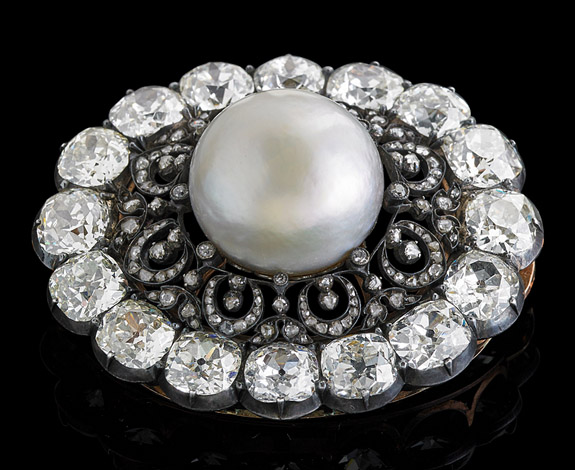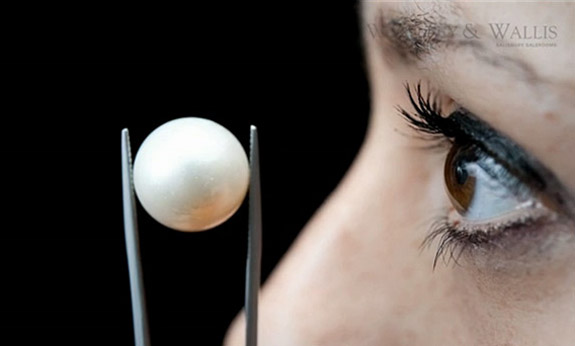Described as “a pearl the size of a quail egg on a cracker of diamonds,” the “Putilov Pearl Brooch” fetched $813,750 at New Jersey’s Rago Auctions on Sunday.

The brooch is centered by the world’s largest near-round natural saltwater pearl, a mammoth specimen that measures 19.08mm x 18.88mm x 16.50mm.
The brooch is framed by 16 near-colorless, old mine cut diamonds with an approximate total weight of 28 carats.
The “Putilov Pearl Brooch” had been owned by the great grandchild of Alexei Putilov, a wealthy Russian financier and industrialist, who carried the 19mm pearl to Paris in the midst of the Russian Revolution in the spring of 1918.
Sunday’s winning bidder was an unnamed Englishman of Russian descent, who made the trip to the U.S. specifically to see the Putilov pearl and take part in the auction. Also in attendance was the Putilov family, who reportedly put the famous jewelry up for auction to generate funds to pay off mounting eldercare bills.
After the brooch was sold, “they were in tears," Sarah Churgin, the head of Rago’s jewelry and silver department, told NJ.com. "They're just lovely people, just so grateful. It’s going to change their lives."
A Pearl Identification Report from the Gemological Institute of America described the Putilov pearl as having a white body color, near-round shape and orient overtone. The pearl is full-drilled, which indicates that it was previously worn as a necklace. The drill holes were subsequently filled with nacreous plugs, according to the report.

The Putilov pearl is estimated to be about 8% larger than the second-largest natural saltwater pearl on record. That pearl, which sold for $1.37 million at British auction house Woolley & Wallis on May 1, 2014, measured 17.44 x 16.51mm.
That specimen was discovered largely by chance. An anonymous woman, who was gifted a pair of drop earrings by her husband, didn’t realize that one of the two was worth more than $1 million.
The earrings had fallen out of style, so she had left them in a locker, forgotten for years. One day, while cleaning up the house, she rediscovered them and decided to get an estimate of what they were worth.
She and her husband met with Jonathan Edwards, the head of the Woolley and Wallis jewelry department. After an examination, Edwards suspected that one of the pearls could be natural. Two independent labs confirmed his suspicions.
Natural pearls are organic gems, created by a mollusk totally by chance, without human intervention. To find one 17mm or 19mm in size is virtually impossible.
Cultured pearls, by comparison, are grown under controlled conditions, where a bead is implanted in the body of the mollusk to stimulate the secretion of nacre. Over time, layer upon layer of nacre creates the deep luster of a pearl.
Images: Rago Arts & Auction House; Woolley & Willis.
No comments:
Post a Comment